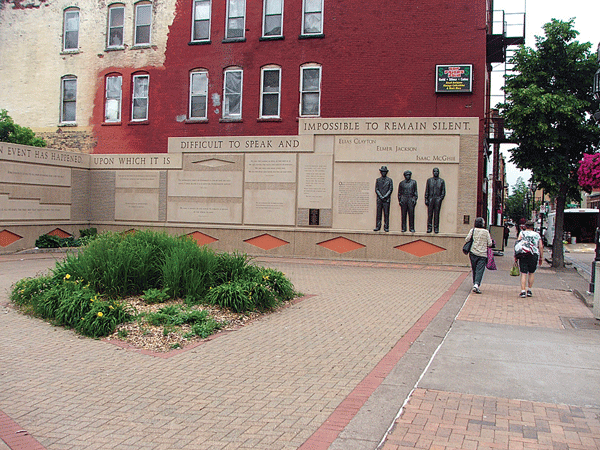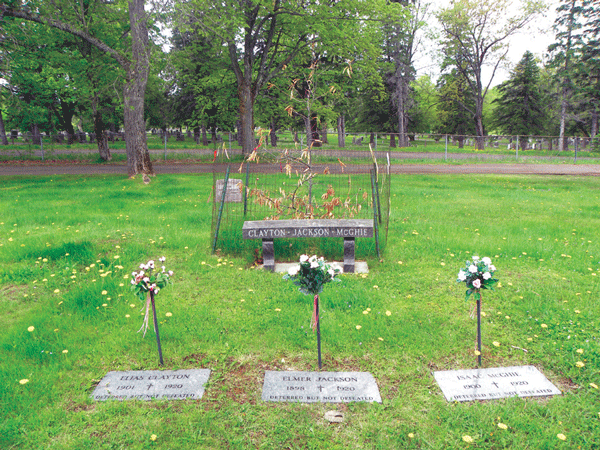News & Articles
Browse all content by date.


On June 27, 2016, the Duluth city council approved a ten-year operating agreement between the Clayton Jackson McGhie Memorial (CJMM) nonprofit organization and the city. The memorial, at 2nd Avenue East and First Street, commemorates the 1920 lynchings of Elias Clayton, Elmer Jackson, and Isaac McGhie. When the young black circus workers were falsely accused of rape by a white Duluth woman, a mob of thousands of Duluth citizens dragged the men from the city jail and hanged them from a lamp post, kitty-corner from where the memorial now stands.
Heidi Bakk-Hansen, secretary of CJMM, came to the microphone to urge the council’s support of the resolution. “Too often in communities a moment of togetherness and public will can be forgotten and memorials can fall, can be forgotten or neglected or even lost, because the institutions left to safeguard them lose track of their promises to themselves. This memorial…is the only one of its kind in the United States. I ask you to think about that for a moment. Duluth, Minnesota is the only community in the United States that has had the moral will to make a serious, downtown-for-all-to-see, large-scale effort at atonement for a public lynching, a murder that as a historical community we participated in.”
Bakk-Hansen, perhaps more than any other one person, is responsible for the memorial’s existence. Almost immediately after the 1920 lynchings occurred, the community chose to forget about them—a self-serving bit of civic amnesia if ever there was one. In 2000, Bakk-Hansen wrote a cover story for the now-defunct Duluth Ripsaw commemorating the 80th anniversary of the lynchings. Most people were astonished that such a thing had ever happened. The article inspired a rush of public engagement. The Minnesota Historical Society re-issued a 1979 book on the event, Michael Fedo’s The Lynchings in Duluth, which had languished forgotten and unread for twenty years, and community organizers started fundraising and lobbying for a memorial. The city purchased the land and three years later the memorial was built.
Today, this shameful event is well-known to Duluthians, and is even taught in the schools, a welcome corrective to the syrupy nostalgia with which the past is so often drenched.
Bakk-Hansen’s article had another result. When an elementary schoolteacher from Washington State named Warren Read began researching his family tree, he came across the Ripsaw article and realized that his great-grandfather Louis Dondino had been one of the mob’s main instigators—a family secret that was kept so well that nobody in the family knew about it. Aided by Bakk-Hansen, Read embarked on further research. He tracked down Elmer Jackson’s hometown of Pennington, Missouri and met Jackson’s descendants at a family reunion. Read eventually wrote a book about confronting the past called The Lyncher in Me. He did a book-signing in Duluth in 2008.
Bakk-Hansen has continued her own CJM research to the present day, digging through newspaper archives and genealogical records for more details about the three murdered men. In 2003, she took a three-week road trip that included stops for research in Baraboo, Topeka, Fort Dodge and Los Angeles. At the Circus History Museum in Baraboo, she found route cards for the John Robinson Circus and she followed that route during her own trip, just to get a sense of what it might have been like to be in a traveling circus circa 1920.
Bakk-Hansen publishes her articles about CJM and other Duluth history on the Zenith City Online website, zenithcity.com. The articles are always well-researched, with plenty of illustrations, and Bakk-Hansen takes the time to establish historical context. In “If We Must Die,” a 2015 Zenith City essay, she explains:
The lynchings in Duluth were only one part of a nationwide paroxysm of racial violence that peaked in 1919. In June 1920 the entire country continued to be convulsed in violent racial hatred and plagued by mass violence. While lynchings and other white-on-black violence occurred more commonly in the South, it was certainly not isolated below the Mason-Dixon line. In 1917 in East St. Louis, thousands of union-led white people burned and ransacked black homes and businesses, leading to the deaths of 40 blacks and eight whites. Six thousand black citizens crossed the Mississippi River to St. Louis seeking safety. On June 26, 1919, 10,000 whites gathered for the lynching of John Hartfield in Ellisville, Mississippi, which had been nationally publicized in advance. The lynching was a grotesque carnival scene: vendors sold flags and souvenirs while Hartfield was hung, mutilated, shot over 2,000 times, and then set on fire until nothing remained of him but ashes….
And while she was addressing the city council, she said:
In 1920, Duluth was not uniquely predisposed to lynchings. In 1920 alone, there were 53 documented lynchings of African-Americans in the United States. The year before, in 1919, there were 76, around 30 of them known to be full-scale riots, and the year after, in 1921, there were 59. Many of these were attended by large mobs fired up by just as much hatred as the one that gathered just a few blocks from here.
A violent campaign of terror by whites against blacks may not be the deed of which our country is most proud, but that’s too bad. Everything Bakk-Hansen writes is firmly anti-nostalgic. Americans of the period were guilty—repeatedly, openly, terribly—of criminal murder. By today’s standards, they were monsters. That’s just as important to think about as, say, Babe Ruth hitting his first home run.
And, of course, Bakk-Hansen notes, “In every single [race riot in 1919], black criminality was blamed, though the vast majority of death and destruction was meted out upon black people, their homes, and businesses by white rioters.”
Of Duluth’s three lynched victims, the most information is known about Elmer Jackson, much of it laid out in Warren Read’s book. Bakk-Hansen has spent years looking for information on Elias Clayton and Isaac McGhie. Although the Internet makes genealogical research easier than it used to be, it is still a painstaking process—work that Bakk-Hansen calls “tedious, frustrating, difficult.”
“You find somebody with the name Isaac McGhie, [and] there’s probably ten or so around the approximate age at that time. Then you trace them, and you find out, did they still appear after 1920? [If they did,] you know it’s not that guy. So you just keep whittling away. But it’s still hard,” she said in a recent interview.
Recently, Bakk-Hansen found a World War I draft card for an Isaac McGhee from Lancaster, New York, who listed his father as Willie McGhee of Danville, Virginia. The lynched Isaac was reportedly from Virginia. When Bakk-Hansen contacted the New York McGhees, a member of the family told her that their Isaac had disappeared in 1920, nobody knew where. When Bakk-Hansen checked the route cards of the John Robinson Circus, she found that the circus had traveled through the Lancaster area in 1920.
It’s circumstantial, but exciting. Bakk-Hansen considers any leads at all to be exciting when researching the lives of poor blacks from 1920. “African-Americans, at that time, tread so lightly on the earth. You just…don’t find them. They’re not easy to find. I think I’ve learned most about how chaotic and disconnected from community these young men were in that time. They’re like the vanguard of the Great Migration in a lot of ways. They’re the first guys going out…from the South, to get the hell out, you know.”
Throughout our conversation, Bakk-Hansen took pains to contrast the historical experiences of blacks and whites. “We think of the Depression, people are riding the rails and stuff, and people maybe don’t even realize how dangerous that was, but to be white and doing that and being black and doing that are two totally different things. You know, all these guys in the Depression hopping the rails and going up to North Dakota to harvest wheat and all of this stuff people used to do, you didn’t want to be a black, non-employed person on the road. You could end up dead just for that fact. It had nothing to do with anything you had done wrong. You were putting yourself at risk just by being there.”
I asked Bakk-Hansen about her statement to the city council that the CJM memorial was the only one of its kind in the country.
“It’s the only lynching memorial of its size in the country,” she said. “There is one, we think, in a Chicago cemetery, so it’s not in a downtown or an accessible area. And there are plaques here and there. But most of the places that have plaques, they had to fight for years just to get that. I mean, places that had HUGE lynchings—Paris, Texas and some of these places—they are still fighting, some of them, to get just a roadside plaque. They can’t get them, because people argue. Or downtown? Forget about it. You might get it, but it’ll be a tiny little plaque on a roundabout. Nobody wants to deal with it. So we are the only one that has a memorial that’s not a plaque, that’s in a downtown, accessible area that people can see.”
Which is quite remarkable, when you think about it—the fact that people would argue about the need to remember the bloody past. A hundred years ago, lynching was mainstream American entertainment—both the act itself and the gory media descriptions that followed (an 1893 newspaper account of a lynching in Paris, Texas mentions that the victim’s “eyes were burned out and irons thrust down his throat” while “every contortion of his body was cheered by the crowd”)—but many people today do not think such things are worth remembering. By building a memorial, Duluth has separated itself from the whitewashers and sentimentalists and taken its place at the head of the line of cities willing to own their history. Bakk-Hansen can be proud of her role in that.
Historical research never ends. Bakk-Hansen said that future CJM-related projects she hopes to complete include locating a city directory for Lancaster, New York in hopes of finding Isaac McGhee’s address; going through the Minnesota Historical Society’s files in Minneapolis in hopes of discovering overlooked information about the lynching; and traveling to Alabama to research the life of Max Mason, the only circus worker who was actually tried for the white woman’s rape (and who was convicted because both he and the alleged victim had gonnorhea). Also, said Bakk-Hansen, “I want to see what I can do with Elias. I think I might have found Elias, but I’m having a hard time tracing him back.”
What have her many years of research taught her? “It’s hard to live with unknowables. I’ve had to come to terms with the reality that you can’t find everything.”
| Tweet |

